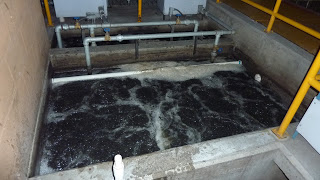How dirty waste makes for clean energy
- Aug 25, 2015
For the past few decades, scientists have experimented with using all kinds of waste, from animal to human, to produce methane gas via anaerobic digestion.
As arguably the largest supplier of organic waste, some large-scale farmers have been an instrumental part of the process, working hand-in-hand with researchers as the go-to source for methane-producing waste. Pioneering farms have been using the technology since the 1980s to harness energy to power their operations.
But, the process isn’t just for farmers anymore. Wastewater treatment facilities are getting in on the action.
How it works
Anaerobic digestion is the process that breaks down organic matter to form methane gas. Decomposed organic matter, plant or animal, is put in a warm, airtight container called a digester. Millions of bacteria break down the matter into organic acids, which become biogas. With typical organic matter, between 55 to 75 percent of this biogas is pure methane.
At that point, the methane gas can be harnessed and used to fuel different energy-producing technologies. Two common technologies are fuel cell and turbine.
Fuel cell technology: Fuel cell technology is considered carbon neutral. With this technology, methane acts as the catalyst for a series of electron-producing reactions that drive a power circuit and produce energy.
Turbine technology: With a turbine, methane is either burned to boil water to produce steam that turns a turbine (steam turbine), or the gas is heated to expand to turn a turbine (gas turbine). Either way, the turbine spins a shaft, which powers a generator.
Dirty waste = clean energy
Wastewater treatment facilities account for 3 percent of the nation’s energy use —considering that those facilities only make up a small amount of the country’s infrastructure, that’s a considerable amount of energy.
But lots of power is required to run the blowers, pumps and other equipment use to treat wastewater. By turning waste into energy, treatment plants are able to reduce their energy consumption — and their cost of operation — while potentially handling even more waste.
It’s a process that’s been gaining attention in Europe and Japan for the past couple decades. The United States now ranks third globally for the number of waste-to-energy treatment facilities.
Though initially wastewater treatment facilities used sewage sludge (mainly human waste) as a way to produce methane, forward-thinking facilities are now experimenting with food waste. That can range from waste grease captured in grease traps to food scraps that might otherwise be dumped in a landfill.
The East Bay Municipal Utility District (EBMUD) in Oakland, Calif., even has food waste from regional restaurants trucked in.
According to the EPA, if just 50 percent of the food waste generated annually by the U.S. was anaerobically digested, it would produce enough energy to power over 2.5 million homes for an entire year.
Though the effectiveness of anaerobic digestion on pre-consumer food waste and sewage is proven, the addition of post-consumer food waste, such as fats, oil and grease, is still in a research stage.
Recent research shows that the introduction of fats, oil and grease from grease interceptors can increase methane production. In a study conducted at North Carolina State University, researchers found that methane production increased by 317 percent when grease was introduced at a rate of 20 percent of volume. However, at 40 percent of volume, methane production decreased. The key is finding the optimum amount.
Paving the way
EBMUD isn’t only notable for its pioneering acceptance of food waste.
In 2012, the wastewater treatment facility became the first in the country to not only produce enough energy to power itself, but it even produced excess electricity to send back to the grid — all from waste material.
EBMUD isn’t the only wastewater treatment facility making headlines for its waste to energy ways. The Newtown Creek Wastewater Treatment Plant (NCWTP) in Brooklyn is working to get America’s largest city hip to the game. By 2015, all of the city’s restaurants will be banned from sending organic waste to the landfill.
Though the million or so tons of organic waste that New York City eateries produce annually might be a bit much for the eight digester eggs at the NCWTP to handle, more digesters are on the horizon.







